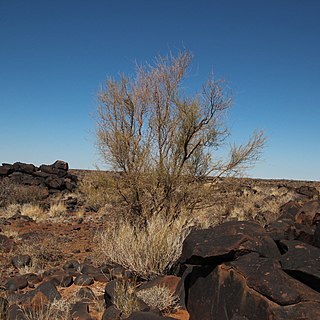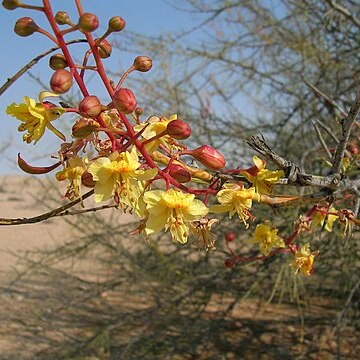A shrub or small tree. It can grow up to 6 m tall. The branches are smooth and flexible. The young branches are bright yellow-green and armed with spines. The tree is normally leafless. Only the midribs of the leaves cling to the tree. When leaflets are present they are narrow and arranged in 8-10 opposite pairs. The flowers are small and yellow. They occur in bunches in the axils of leaf stalks and at the ends of branches. The pods are 10-15 cm long. They are reddish brown and compressed between the seeds. There are about 8 seeds per pod and they are oblong and shiny.
Pods 5–12 × 0.6–0.8 cm, linear, flattened, straight or curved, often somewhat constricted between the seeds, glabrous, light grey-brown; seeds up to 8 per pod but often fewer (frequently only 1 or 2 developing), 7–9.5 × 5–6 × 2–3 mm, obovate to oblong, elongated longitudinally in the pod with the hilum at one end, light brown with dark markings.
Slender, spiny shrub or small tree, 3-4(-6) m tall, with pale yellowish stems. Leaves often absent at flowering, alternate or clustered in axils of spines, twice pinnate, mainly a bare green rachis, with tiny rachillae and leaflets. Flowers in racemes from spine axils, yellow. Pod long and slender, narrowed at base and apex.
Leaves reduced to one or two pairs of sessile, green pinna rachides (2)5–14 cm long, slightly grooved on the upper surface, with up to 15 nodes but no leaflets, or occasionally with very small linear or oblanceolate leaflets up to 1.5 mm long.
Receptacle comprising a disc up to 3 mm radius which usually breaks away in fruit to form a small collar, and a lower elongate part up to 10 mm long simulating the pedicel, shorter or longer than the pedicel proper.
Flowers in fairly lax racemes up to 16 cm long; bracts up to 1.5 mm long, ± ovate, caducous; pedicels 3–10 mm long excluding the very elongate lower part of the hypanthium.
Stems subglabrous or occasionally finely pubescent when young, armed with stout spines which are modified lateral shoots and may often be branched and bear leaves.
Sepals 5–8 mm long, ± oblong, narrowly imbricate, becoming reflexed in full flower, with short sparse hairs or subglabrous.
Petals 7–12 mm long, the standard with a distinct claw and ± reniform blade, all yellow.
Stamens about equalling or slightly exceeding the petals; anthers 1–1.7 mm long.
Ovary glabrous or with sparse whitish hairs, particularly on the margins.
Shrub or small tree up to 7 m high.



